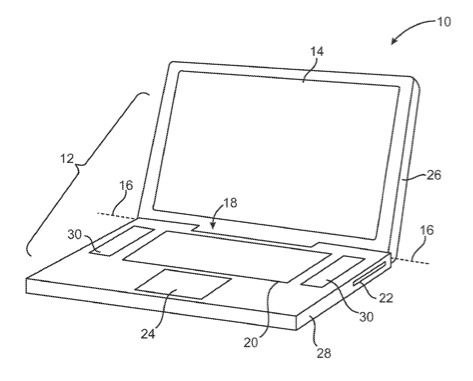An Apple patent (number 8199477) for portable computers with spring-mounted displays has appeared at the U.S. Patent & Trademark Office. This invention relates to electronic devices and, more particularly, to electronic devices that have displays such as portable computers.
Per the patent, an electronic device housing may contain a display module. The display module may contain layers of material such as a color filter layer and a thin-film transistor layer. These layers of material may be mounted in a display module chassis. A cover glass may cover the display module. The housing may have springs that mate with corresponding holes in the chassis of the display module to hold the display module in place within the housing.
The springs may flex about a flex axis that is perpendicular to a planar rear housing surface and the planar layers of the display module. A disassembly tool may be inserted into a gap between the cover glass and housing sidewalls. When the disassembly tool is rotated, a fin on the tool may press against an engagement structure in the spring and may release the spring from the display module.
Here’s Apple’s background and summary of the invention: “Portable computers typically have upper and lower housing portions that are connected by a hinge. The lower housing portion contains components such as printed circuit boards, disk drives, a keyboard, and a battery. The upper housing portion contains a display.
“When the computer is in an open configuration, the upper housing portion is vertical and the display is visible to the user of the portable computer. When the computer is closed, the upper housing lies flat against the lower housing. This protects the display and keyboard and allows the portable computer to be transported.
“Portable computer displays typically contain fragile structures such as layers of glass and can be challenging to mount properly within the upper housing. If care is not taken, the display and the surrounding portions of the upper housing will be bulky and unsightly. At the same time, the elimination of certain structures in the display may result in display that is overly fragile. This could lead to damage to the display during normal use. It would therefore be desirable to be able to provide improved display structures in electronic devices such as portable computers.
“The housing may be formed from a material such as metal and may have a planar rear surface and peripheral housing sidewalls. The display module may contain layers of material such as a color filter layer, polarizer layers, a liquid crystal layer, and a thin-film transistor layer. These layers of material may be mounted in a metal display module chassis member.
A cover glass member may cover the display module. The cover glass may have a peripheral edge that is adjacent to the peripheral housing sidewalls. A gap may be formed between the cover glass peripheral edge and the peripheral housing sidewalls. The gap may be filled with an elastomeric trim member.
“The housing may have springs that mate with corresponding holes in the chassis member of the display module to hold the display module in place within the housing. The springs may flex about a flex axis that is perpendicular to a planar rear surface of the housing and the display module. A disassembly tool may be inserted into the gap between the cover glass and housing sidewalls after the trim has been removed. The end of the shaft of the disassembly tool may be received within a pilot hole in the housing. When the disassembly tool is rotated, a fin on the tool may press against an engagement structure in the spring and may release the spring from the display module. This allows the display module to be removed from the housing for servicing.
The inventors are Dinesh C. Mathew, Thomas W. Wilson Jr., Nicolas Alan Rundle and Bryan W. Posner.
Also appearing today is a patent (number 8200881) for communication between a host device and an accessory via an intermediate device. It relates generally to communication of information between electronic devices and in particular to communication of information between a host device and an accessory via an intermediate device. The inventors are Gregory T. Lydon, Jay S. Laefr, John Ananny and Terry Tikalsky.



